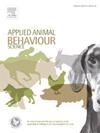Investigating the motivations of repetitive barrier interactions in Pogona vitticeps
IF 2.2
2区 农林科学
Q1 AGRICULTURE, DAIRY & ANIMAL SCIENCE
引用次数: 0
Abstract
Considerable research has demonstrated that the effective management of repetitive behaviours such as bar-biting and pacing relies upon understanding their motivations; however, this same research has revealed that repetitive behaviours can have a diverse array of motivations. In reptiles, repetitive behaviours commonly manifest as persistent interactions with the barriers of the enclosure (hereafter IWB). It is typically assumed that IWB indicates a motivation to escape the enclosure, but this has not been investigated; consequently, this assumption is the hypothesis of this article. Two predictions followed from this: IWB should be biased towards known and visible escape routes and should be associated with other factors that may increase a lizards’ motivation to escape. We found that within their enclosures, lizards performed IWB for longer on the only known escape route. Furthermore, when this area was made partially opaque, IWB was biased towards the remaining transparent portion. However, the association of IWB with other factors was less clear. IWB was strongly associated with defecation, but the cause-and-effect of this relationship was unclear. In addition, IWB was not associated with feeding, although this may be related to the generally sedentary life histories of P. vitticeps. Finally, female lizards performed more IWB than males during the breeding season, but the opposite was predicted based on the movement patterns of wild P. vitticeps; this may reflect that IWB is related to the motivation to gain certain resources, but not necessarily to be active. In conclusion, there was evidence that IWB was related to a motivation to escape the enclosure, but as with other research, we found that IWB had diverse motivations that are linked to the animal’s life history.
求助全文
约1分钟内获得全文
求助全文
来源期刊

Applied Animal Behaviour Science
农林科学-行为科学
CiteScore
4.40
自引率
21.70%
发文量
191
审稿时长
18.1 weeks
期刊介绍:
This journal publishes relevant information on the behaviour of domesticated and utilized animals.
Topics covered include:
-Behaviour of farm, zoo and laboratory animals in relation to animal management and welfare
-Behaviour of companion animals in relation to behavioural problems, for example, in relation to the training of dogs for different purposes, in relation to behavioural problems
-Studies of the behaviour of wild animals when these studies are relevant from an applied perspective, for example in relation to wildlife management, pest management or nature conservation
-Methodological studies within relevant fields
The principal subjects are farm, companion and laboratory animals, including, of course, poultry. The journal also deals with the following animal subjects:
-Those involved in any farming system, e.g. deer, rabbits and fur-bearing animals
-Those in ANY form of confinement, e.g. zoos, safari parks and other forms of display
-Feral animals, and any animal species which impinge on farming operations, e.g. as causes of loss or damage
-Species used for hunting, recreation etc. may also be considered as acceptable subjects in some instances
-Laboratory animals, if the material relates to their behavioural requirements
 求助内容:
求助内容: 应助结果提醒方式:
应助结果提醒方式:


